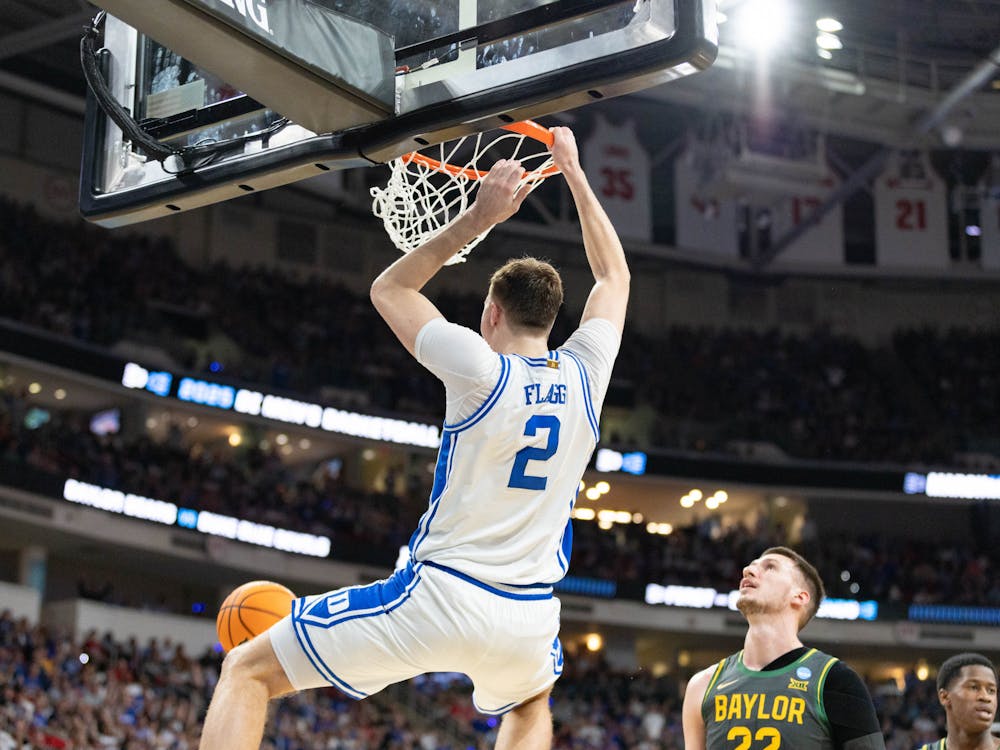5 Halftime Observations from No. 1-Seed Duke Men’s Basketball’s NCAA Tournament Contest Against Baylor
In the first half of Duke’s NCAA Tournament matchup against Baylor, the Blue Devils showcased their immense talent, athleticism, and championship potential. By halftime, Duke had built a commanding lead of 47-30, largely due to a balanced offensive attack and an unrelenting defense that stifled Baylor’s efforts. The first 20 minutes were a testament to the high-level play that Coach Jon Scheyer has cultivated in his first season at the helm, with several players stepping up to take control of the game.
As Duke heads into the second half with a substantial lead, here are five key observations from the first half that reflect both Duke’s dominance and Baylor’s struggles:
1. Tyrese Proctor’s Poise and Playmaking Shine
Tyrese Proctor, Duke’s standout freshman guard, was the focal point of the Blue Devils’ offensive efforts in the first half. Proctor demonstrated why he is one of the most highly regarded players in the country, contributing 16 points, 4 assists, and 3 rebounds in the first 20 minutes. His ability to make plays both for himself and his teammates was evident early on, as he hit multiple 3-pointers and also finished in the paint, showing off a diverse scoring arsenal.
What stood out the most, however, was Proctor’s poise and maturity on the court. Despite being just a freshman, Proctor appeared unfazed by the stage and the intensity of the NCAA Tournament. He was able to control the tempo of the game, moving the ball with precision and creating opportunities for his teammates. Whether he was hitting jump shots, finding open players, or driving to the basket, Proctor’s all-around performance was the key catalyst for Duke’s offensive efficiency.
Moreover, Proctor’s defense was equally impressive. He didn’t just contribute on the offensive end; his ability to disrupt Baylor’s ball movement and defend in transition helped keep the Bears from gaining any momentum. As a result, Duke’s offense looked fluid, and Baylor was forced to play catch-up all throughout the first half.
For Duke to maintain their lead and continue their march to the Sweet 16, Proctor will need to keep playing with this level of confidence and efficiency. His performance in the first half proved that he is not only capable of handling the pressure but also of thriving in high-stakes situations.
2. Duke’s Defensive Dominance and Disruption
One of the most striking aspects of Duke’s performance in the first half was their suffocating defense. The Blue Devils’ defensive game plan was executed to perfection, limiting Baylor’s opportunities and forcing them into difficult shots. Coach Jon Scheyer’s defensive schemes — especially in the paint and on the perimeter — made it extremely difficult for Baylor to generate consistent offense.
Duke’s defense, spearheaded by 7-foot-1 center Dereck Lively II, was disruptive in every sense. Lively was a force on the inside, rejecting shots, altering others, and grabbing critical rebounds. His presence in the paint was overwhelming for Baylor’s frontcourt players, and it led to Baylor settling for more outside shots than they would have liked. Even when the Bears did manage to get into the paint, Lively’s shot-blocking ability forced them to alter their attempts, making it difficult for Baylor to score consistently.
In addition to Lively, Duke’s perimeter defense was equally impressive. Guards like Jeremy Roach and Tyrese Proctor did an excellent job staying in front of Baylor’s shooters, contesting shots, and preventing easy looks from beyond the arc. As a result, Baylor’s leading scorers, Adam Flagler and LJ Cryer, were forced to take tough, contested shots. Cryer, in particular, struggled to find any rhythm in the first half, contributing to the Bears’ overall offensive struggles.
Duke’s defensive strategy of switching on screens, pressuring the ball, and closing out on shooters effectively minimized Baylor’s opportunities. Their ability to execute these defensive principles with precision is what set the tone for the entire first half.
3. Balanced Scoring and Offensive Efficiency
One of the biggest strengths of the Duke team this season has been its balanced scoring attack, and that was on full display in the first half. While Proctor was the primary scorer, contributing the lion’s share of points, several other players played crucial roles in extending Duke’s lead.
Kyle Filipowski, Duke’s talented freshman forward, was a constant presence on both ends of the floor. Filipowski’s 3-point shooting, combined with his ability to finish inside, helped Duke maintain a steady flow of offense. His versatility, being able to stretch the floor while also banging in the paint, made him a matchup nightmare for Baylor’s defenders. Filipowski finished the first half with 9 points and 5 rebounds, providing key scoring when Duke needed it most.
Duke’s offense wasn’t just about individual performances, however. The team’s ball movement and shot selection were also a significant factor. The Blue Devils had 11 assists in the first half, showcasing their ability to share the basketball and create open shots for teammates. Rather than relying on isolation plays or one-on-one matchups, Duke’s offense ran through its ball movement, finding high-percentage shots and executing efficiently.
Jeremy Roach, the experienced point guard, was a major facilitator for Duke’s offense, contributing 4 assists while also chipping in with 6 points. His ability to orchestrate the offense and keep his teammates involved helped maintain a steady offensive flow, even as Baylor attempted to cut into Duke’s lead.
This balanced offensive attack, where multiple players were contributing both on the scoreboard and through assists, is a crucial aspect of Duke’s game. As they move deeper into the tournament, this offensive efficiency — combined with their defensive prowess — will make them a tough team to beat.
4. Baylor’s Struggles with Shot Selection and Offensive Execution
While Duke was executing their game plan with precision, Baylor was struggling to find any rhythm on offense. The Bears, known for their quick-paced, high-scoring style of play, were stifled by Duke’s defense and unable to consistently generate open looks. The combination of poor shot selection and Duke’s defensive pressure led to a frustrating first half for Baylor.
Baylor’s shooters, particularly Adam Flagler and LJ Cryer, were both unable to get comfortable. Cryer, who had been a major factor in the Bears’ earlier tournament victories, had only 4 points at halftime, largely due to Duke’s tight perimeter defense. Flagler, meanwhile, had 8 points but struggled to make an impact as Duke kept him from getting into a flow. Both players, who typically thrive on their ability to shoot from long range, found themselves forced into contested shots, often with little time on the shot clock.
Baylor also had trouble establishing any kind of consistent offense in the paint. Duke’s interior defense, anchored by Lively, limited the Bears’ opportunities to score inside. Baylor’s forwards struggled to finish in the paint, and when they did get looks, they were often contested by Lively or forced into difficult angles. The Bears were left to rely on outside shooting, which wasn’t falling consistently.
The lack of offensive balance and execution was a major factor in Baylor’s inability to make any significant run in the first half. They had to fight for every point, and the Blue Devils’ defense made it difficult for them to generate any momentum.
5. The Importance of Maintaining Focus and Discipline in the Second Half
As Duke heads into the second half with a 17-point lead, maintaining focus and discipline will be crucial for closing out the game. The Blue Devils cannot afford to let up or become complacent, as Baylor is more than capable of going on a scoring run. While Duke has done an excellent job in the first half, especially with their defensive intensity and offensive efficiency, they must remain mentally sharp to avoid giving Baylor an opportunity to claw their way back into the game.
One of the most important factors for Duke in the second half will be controlling the tempo. The Blue Devils must continue to play at their pace, dictating the game with their ball movement and defensive intensity. They cannot afford to let Baylor speed up the game, as that’s when the Bears are most dangerous. If Duke continues to play smart basketball and makes the right decisions offensively, they should be able to extend their lead and cruise to victory.
A Dominant First Half but the Job Isn’t Finished
Duke’s 47-30 lead at halftime was an impressive display of both offensive firepower and defensive dominance. Tyrese Proctor’s stellar performance, combined with contributions from Filipowski, Roach, and Lively, has given the Blue Devils a solid cushion heading into the second half. Their defense has been suffocating, forcing Baylor into difficult shots and disrupting their offensive flow.
However, the job is far from finished. Baylor, despite their struggles, has the talent and experience to make a run in the second half. Duke must continue to execute their game plan, stay disciplined on defense, and maintain their offensive efficiency if they want to close out the game and advance to the Sweet 16.
With a strong first half behind them, Duke has shown why they are the No. 1 seed, but the true test will be how they respond in the second half. If they continue to play with the same level of intensity, they’ll be well on their way to securing a spot in the next round of the tournament.



